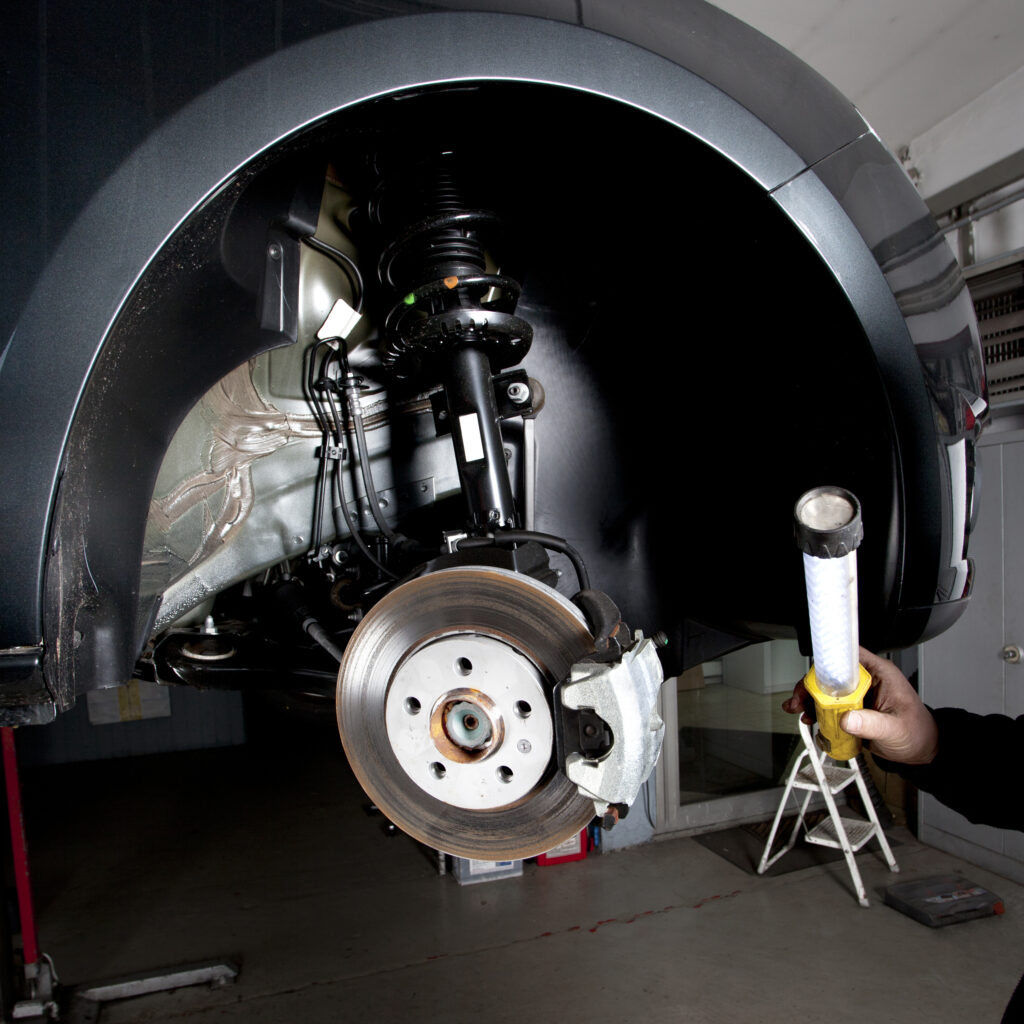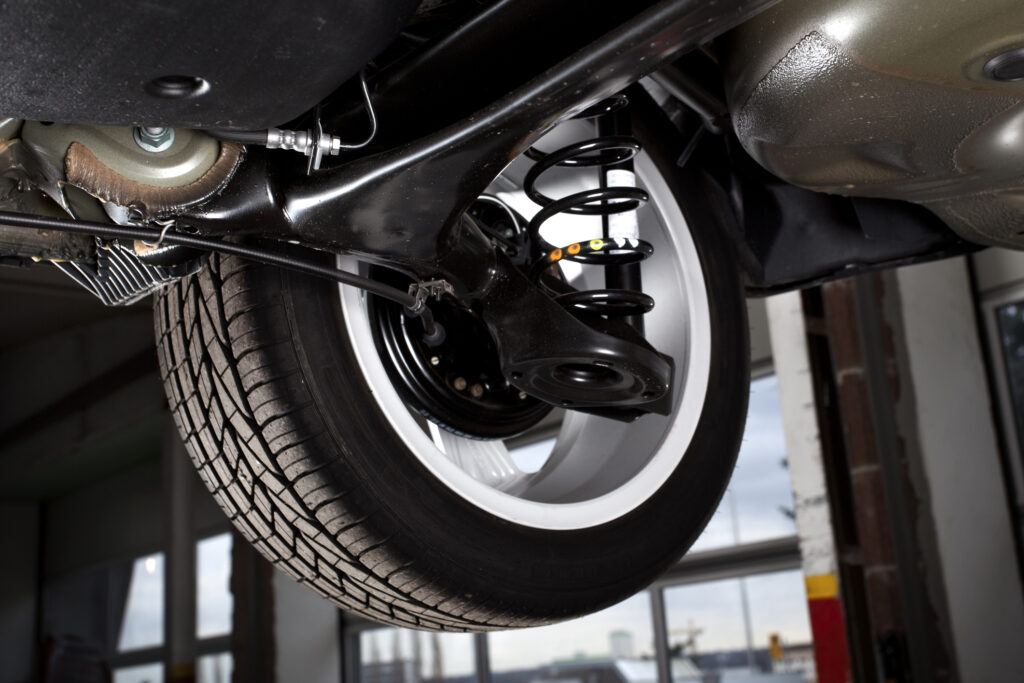Symptoms of shock absorber wear
Wear of shock absorbers occurs gradually, so assessing their condition properly is not easy. However, there are a few signs of wear that should set off a red light in your mind. What are the most common signs of shock absorber wear? When does accelerated wear of shock absorbers occur and is it possible to check the condition of shock absorbers by home means?
Shock absorbers act as vibration dampers in the suspension system. When driving over bumps, potholes or off-road obstacles, the car’s wheels are supported by spring elements. At present these are mainly springs, but leaf springs are also available from Magnum for light commercial vehicles. However, whilst springs effectively flex when the wheel comes into contact with uneven ground, they also tend to vibrate strongly.
This is prevented by the shock absorber, which provides resistance to the springs via an oil and valve system.

Symptoms of shock absorber wear
The easiest way to recognise signs of shock absorber malfunction is to drive over lateral obstacles such as railways, kerbs and speed bumps. A fully functioning car overcomes these obstacles without problems and quickly regains stability. However, if the performance of the shock absorbers is insufficient, the car body will continue to rock for a long time. This is not only uncomfortable, but also dangerous. An unstable body behaves unpredictably during manoeuvres and it’s easy to lose control of the steering wheel.
Over time, directional problems may also occur. A car with faulty shock absorbers sways from side to side, e.g., when cornering or driving over bumps. The characteristic skidding often occurs on motorways at higher speeds. It is also dangerous when leaving a forest or when passing lorries. A sudden gust of wind can easily destabilise a vehicle in which the shock absorbers are not spring-loaded

Other signs of shock absorber wear include:
- extended braking distances – less wheel pressure on the road weakens the grip of the tyres,
- uneven tyre wear – a characteristic symptom of a defective shock absorber is an unevenly worn tyre. The tyre surface is ragged and irregular. This effect is more pronounced on the front wheels,
- frequent and inadequate reaction of the ABS system – incorrect pressure of the wheels on the road makes it difficult for the system to react properly,
- “diving” of the front of the vehicle during heavy braking – the sudden shift of the centre of gravity to the front causes the body jerk,
- “squatting” of the rear of the car at the moment of starting and dynamic acceleration – strongly rising bonnet and falling back after acceleration are some of the most common symptoms of defective shock absorbers,
- frequent striking of the suspension – lack of suspension damping may lead to the so-called striking, i.e., hitting the control arm against the rubber rebound,
- body jerking on a sudden change of direction – performing a sudden manoeuvre makes the springs rapidly give up energy and destabilise the car. In extreme cases the wheels may detach from the road surface,
- Seat and bench seat bouncing – if the driver’s and passengers’ bodies are bouncing on driving over lateral bumps, the shock absorbers are not working properly,
- Increased understeer or oversteer – a car with faulty shock absorbers tends to skid forward out of the line of travel. In some cases, oversteer, or wheel spin, occurs on the rear axle,
- rattling coming from the suspension – defective shock absorber mounts can produce unpleasant rattling noises on rough roads,
- delayed reaction to steering – a car with defective shock absorbers drives with considerable resistance and the body does not keep up with the wheels.
How to check the condition of shock absorbers?
It is best to have the performance of your shock absorbers measured at a good garage or diagnostic station. This is one of the elements of each periodic technical inspection. A special machine is used, which vibrates the wheels and checks the effectiveness of the damping. The results are not always conclusive, as they are influenced by the profile of the tyres. Tyres with a higher sidewall perform better in shock absorber tests than those with a low profile. Properly functioning shock absorbers are between 40 and 80% efficient. Some mechanics recommend replacing them at 50% efficiency. It is worth noting that even freshly unpacked shock absorbers will not achieve 100% efficiency in tests – such a result indicates poor calibration of the device.
Are there any methods for checking the condition of shock absorbers by yourself? The simplest method is to press firmly on the body just above the wheel. The body should then make a maximum of 1-2 swings and quickly stabilise its position. This is accompanied by the characteristic hiss of a properly damped shock absorber. If the body continues to rock for too long, the shock absorbers should be replaced. You can also diagnose damage visible to the naked eye yourself: corrosion, bent piston rod, oil leakage or damage to the metal-rubber mount.
Are there ways to extend the life of shock absorbers?
Another way to replace shocks less often is to take it easy while driving. The absence of sudden manoeuvres, hard braking and “jerky” driving also has an effect on the condition of the suspension. In addition, driving slowly makes it easier to notice a pothole and avoid it. Driving into a pothole is unfortunately a common cause of shock absorber damage, especially if the shock absorber hits the limiter in the process. Due to the sudden high pressure the piston rod can leak and oil can escape.
Shock absorbers are consumable parts, so they naturally wear out when driving and need to be replaced regularly. There are few ways to prolong the life of shock absorbers. The best way is to avoid uneven roads, kerbs, tracks and other obstacles that cause shock absorber wear.

How many kilometres should I replace shock absorbers?
The life of a shock absorber depends on many factors, including driving style, road quality and vehicle weight. It is assumed, however, that classic oil-filled shock absorbers should last about 70-80,000 km. Air-oil shock absorbers have a slightly shorter service life, as their construction is more delicate. In return, they have a very quick response, which is very important, especially when driving at high speeds.
Keep in mind that you should always replace both shock absorbers. Even if only one of them leaks or is damaged, the other must also be replaced. This is because the difference in damping force between two shock absorbers on the same axle must not be greater than approx. 20%. Such a deviation from the norm would cause the car to lose its stability and the grip of both wheels would not be the same.
Do not delay with the replacement of shock absorbers, especially if you notice traces of oil, cracks or advanced corrosion. It may turn out that the piston rod moves freely in the cylinder and does not dampen the springs in any way. Replacement of shock absorbers should be entrusted to a trusted garage that not only does it well, but also sets the correct suspension geometry. If the mechanic skips this step and does not adjust the wheel alignment, the car will continue to drive inaccurately.
